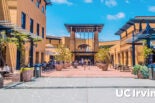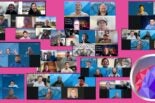By Tom Andriola. I have noticed IT people don’t particularly like high-level, fluffy discussions. They would rather hear specific use cases. So I am going to do both in this article, start with the use cases and then work up to a broad view of collaboration for the good of higher education. Collaboration. It is one of those words that if you ask ten people what it means, you get eleven different definitions. I am going to define a few simple use cases to illustrate what I mean by collaboration and how the University of California has thought about it. I contend all three are reasonable arguments for why collaboration makes sense.
- Use case 1: You and I work together to come up with a solution. By leveraging each others’ strengths, the solution is better than each one of us could have come up with individually.
- Use case 2: You and I work together to come up with a solution that gets finished and is in place for users faster because we have shared the burden of time and resources.
- Use case 3: You have a great solution and I don’t. I work with you to adapt your solution to my environment, which is a much easier and cheaper path than if I tried to do it on my own.
To be sure, I haven’t spent my whole career in higher education—just four years—and many still consider me a newbie. But that gives me a somewhat neutral perspective. And one of my observations is I hear people say they are so busy they don’t have time to do anything beyond their regular job. But they certainly have time to reinvent the wheel. They have time to solve a problem that has been solved many times over, and in many places. I find this ironic. How, in such a financially constrained industry can we justify such a wasteful mindset? Are we really so unique that my problem for classroom assignments is different from yours, or your need for a grant database is different from mine? This is not a uniqueness issue. This is a mindset issue.
Collaboration would be much more effective for us in higher ed if we challenged the fundamental paradigm about needing to be unique. At the University of California, we are a living experiment in collaboration—a university system made up of ten campuses and six health systems, each with its own CIO and IT functions. At each of our campuses, IT functions exist not only in a central IT unit but also across the campus in the academic and other departments. This broadly defined IT community counts 7,500 people. That’s right—7,500 people who come to the university every day to make a difference for our students, faculty, staff, and each other.
I see that as 7,500 opportunities, and when I joined UC, I asked a somewhat novel but simple question: What if these 7,500 people had the ability to leverage the collective knowledge and experience of our community, and so could deliver increased value to the mission at unparalleled speeds? That has become our grand experiment—finding ways to answer questions more quickly, finding for our problems the solutions that already exist.
At this point we are not talking about technology. We are talking about architecture—the architecture of culture and change. How do we design an organizational capability and culture for people to connect fast and meaningfully to answer questions and solve problems? I believe it’s not only what is expected of us, but is very much within our reach if we purposefully build the collaborative fabric and mindset to leverage our collective capabilities.
Today at the University of California we are well down the path of building that capability and rewiring the cultural norms. The CIOs are sponsoring and indeed cultivating a UC IT community of 7,500 professionals through a variety of mechanisms, including a blog and a LinkedIn group. I would like to highlight three critical threads in our experiment: governance, service, and professional development.
First, we actively tap our community to help with governance and strategy: We have established various systemwide staff committees, defined by topic, that focus on activities where working together offers greater value to each campus and the system as a whole. Examples are committees on research IT, educational technology, IT procurement, and IT accessibility. They are charged with articulating the most important problems and strategic goals in their areas, and coming up with shareable solutions.
Second, with the help of the Slack collaboration platform, we have created an easy way for communities of interest to find each other, hold meaningful conversations, and find and exchange solutions. We do not manage this; it’s organic. You are not required to join; you are invited. And people do join. They engage because they are passionate about serving the university. They stay engaged because they find solutions to their IT problems and derive value from the sense of community and belonging. They feel they are serving something larger than themselves.
Finally, helping people understand collaboration is like developing any other skill or competency. There is a body of knowledge around it. There are techniques you can learn to make it work better for you, and one becomes better at it through practice. We have incorporated collaboration into our leadership development programs as one of the three core competencies—as important as leadership and innovation. At the end of the day, does any of this make a difference?
Though we still have a long way to go, we are growing success stories. For example:
- A UC San Diego risk and safety application served as a starting point for UC Davis, which then built it into a full-fledged suite of risk and safety solutions used by all the UC campuses and medical centers.
- An academic review and recruitment system was developed at one campus and adopted by others because it was better than what they had and they could get it into place quickly.
- Two UC locations chose to share a major health records platform, rather than buy separate ones. This bold move saved tens of millions of dollars in capital that could be invested back into the mission.
So yes, collaboration can bring better, faster, and cheaper results. In all cases, the IT people involved enjoyed collaborating with colleagues and derived satisfaction from the experience. The university gained greater value from its IT workers, simply because they felt a renewed sense of being in service to the mission. So in the final analysis, collaboration benefits both the institution and the people who make up the institution. Our goal now is to figure out how to scale this process, make it repeatable, and accelerate it. In my mind, the University of California is simply better for collaboration. That’s a mindset we should all be able to embrace.
This article was first published in the April 2018 edition of Education Technology Insights and is re-posted in the UC IT Blog with permission.
 Tom Andriola is chief information officer for the University of California system.
Tom Andriola is chief information officer for the University of California system.








Great Article!
“This is not a uniqueness issue. This is a mindset issue.”
Thank you for saying it so plainly and in a way that makes clear that we CAN collaborate, if only we choose to change our minds(et).
I couldn’t agree more. And I think that choice is to BE one university, not just say that we are.